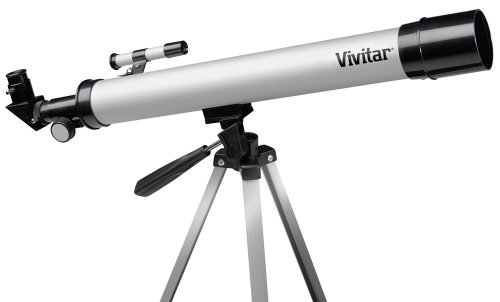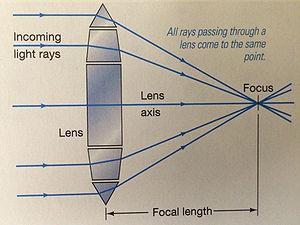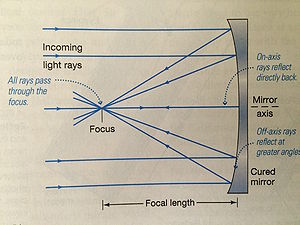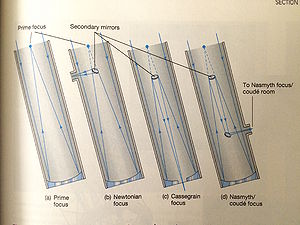Telescopes: Difference between revisions
Wgreenwald3 (talk | contribs) No edit summary |
Wgreenwald3 (talk | contribs) |
||
| (19 intermediate revisions by 2 users not shown) | |||
| Line 1: | Line 1: | ||
Telescopes are tools used to study the night sky. The key to any telescope is getting as much information from the night sky as possible. This is done by taking advantage of the physical properties of light. | Telescopes are tools used to study the night sky. The key to any telescope is getting as much information from the night sky as possible. This is done by taking advantage of the physical properties of light. | ||
==The Main Idea== | ==The Main Idea== | ||
Telescopes utilize systems of [[Mirrors]] and [[Lenses]] (sometimes very complicated) to take as much information from light as possible. Most telescopes used today are reflecting telescopes. The two major types of visible light telescopes are reflecting and refracting. Reflecting telescopes tend to be more compact and easier to maintain. The [[Quantum Properties of Light]] allow scientists to model light as both a particle and a wave as it bounces off mirrors and refracts through transparent mediums. | |||
===Parts of a Telescope=== | |||
The two major parts of a telescope are the objective lens and the eye piece. The most complicated structures come from reflecting lens. | |||
[[File:31mSg3OkZ0L.jpg|500px|]] | |||
===Important Equations=== | |||
= | Magnification is equal to the focal length of the objective lens divided by the focal length of the eyepiece. | ||
<math> \mathbf{M} = \frac{F} {f} </math> | |||
The light gathering ability of a telescope is equal to the area of its objective lens. | |||
= | <math> \mathbf{LGA} = (pi)*R^2 </math> | ||
= | R=Radius of objective lens | ||
The resolution of an image is dependent on the wavelength of the light being observed. Resolution of the image (in arc-seconds) is equal to a constant multiplied by the wavelength divided by the diameter of the telescope. | |||
<math> \mathbf{α} = \frac{2.5e5*λ}{D} </math> | |||
== | ===Refracting Telescopes=== | ||
Refracting telescopes use a lens to gather and concentrate a beam of light. The lens can be thought of as a series of prisms combined in such a way that all the light waves arrive parallel to the axis (which is the line through the center of the lens). [[Refraction]] is the bending of light as it passes through a transparent medium. | |||
[[File:IMG 3035.JPG|300px|]] | |||
===Reflecting Telescopes=== | |||
Reflecting telescopes use a curved mirror instead of a lens to focus the incoming light. The focal length of a reflecting telescope is equal to the total distance the light travels in-between reflection from mirror to mirror. | |||
[[File:IMG 3036.JPG|300px|]] [[File:IMG 3038.JPG|300px|]] | |||
=== | ===Different Models of Reflecting Telescopes=== | ||
[[File:IMG 3037.JPG|300px|]] | |||
== | ==Connectedness== | ||
As an aerospace engineering major, I found this topic to be very related to my major. Aerospace vehicles are often used to place telescopes in better locations for observation. | |||
==History== | |||
The earliest telescopes were refracting telescopes. [[Galileo Galilei]] was one of the first notable people to use a telescope to observe the night sky. Galileo's telescope was a simple refracting and was the best at its time. He used it to observe many celestial objects including Mars and even 4 of Jupiters moons. | |||
==References== | ==References== | ||
#"Telescope - Google Search." Telescope - Google Search. N.p., n.d. Web. 05 Dec. 2015. | |||
#Chaisson, Eric, and Steve McMillan. "Astronomy Today." Astronomy Today. Pearson, n.d. Web. 05 Dec. 2015. | |||
#http://www.astronomy.gatech.edu/Courses/Phys2021/ | |||
Latest revision as of 18:41, 6 December 2015
Telescopes are tools used to study the night sky. The key to any telescope is getting as much information from the night sky as possible. This is done by taking advantage of the physical properties of light.
The Main Idea
Telescopes utilize systems of Mirrors and Lenses (sometimes very complicated) to take as much information from light as possible. Most telescopes used today are reflecting telescopes. The two major types of visible light telescopes are reflecting and refracting. Reflecting telescopes tend to be more compact and easier to maintain. The Quantum Properties of Light allow scientists to model light as both a particle and a wave as it bounces off mirrors and refracts through transparent mediums.
Parts of a Telescope
The two major parts of a telescope are the objective lens and the eye piece. The most complicated structures come from reflecting lens.

Important Equations
Magnification is equal to the focal length of the objective lens divided by the focal length of the eyepiece.
[math]\displaystyle{ \mathbf{M} = \frac{F} {f} }[/math]
The light gathering ability of a telescope is equal to the area of its objective lens.
[math]\displaystyle{ \mathbf{LGA} = (pi)*R^2 }[/math]
R=Radius of objective lens
The resolution of an image is dependent on the wavelength of the light being observed. Resolution of the image (in arc-seconds) is equal to a constant multiplied by the wavelength divided by the diameter of the telescope.
[math]\displaystyle{ \mathbf{α} = \frac{2.5e5*λ}{D} }[/math]
Refracting Telescopes
Refracting telescopes use a lens to gather and concentrate a beam of light. The lens can be thought of as a series of prisms combined in such a way that all the light waves arrive parallel to the axis (which is the line through the center of the lens). Refraction is the bending of light as it passes through a transparent medium.
Reflecting Telescopes
Reflecting telescopes use a curved mirror instead of a lens to focus the incoming light. The focal length of a reflecting telescope is equal to the total distance the light travels in-between reflection from mirror to mirror.
Different Models of Reflecting Telescopes
Connectedness
As an aerospace engineering major, I found this topic to be very related to my major. Aerospace vehicles are often used to place telescopes in better locations for observation.
History
The earliest telescopes were refracting telescopes. Galileo Galilei was one of the first notable people to use a telescope to observe the night sky. Galileo's telescope was a simple refracting and was the best at its time. He used it to observe many celestial objects including Mars and even 4 of Jupiters moons.
References
- "Telescope - Google Search." Telescope - Google Search. N.p., n.d. Web. 05 Dec. 2015.
- Chaisson, Eric, and Steve McMillan. "Astronomy Today." Astronomy Today. Pearson, n.d. Web. 05 Dec. 2015.
- http://www.astronomy.gatech.edu/Courses/Phys2021/



